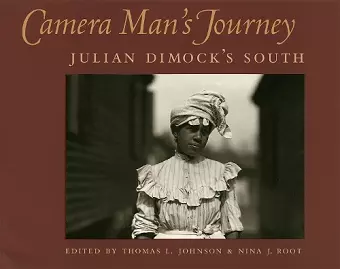Camera Man's Journey
Julian Dimock's South
Nina J Root editor Thomas L Johnson editor
Format:Hardback
Publisher:University of Georgia Press
Published:1st Jul '02
Currently unavailable, and unfortunately no date known when it will be back

A poignant collection of 150 photographs, Camera Man's Journey takes us to a place at once familiar and foreign. Set in the South early in the twentieth century, these photographs bridge a distance not only of time but also of contrasting attitudes and customs.
The images show African Americans in or around Columbia, Beaufort, and Hilton Head, South Carolina. Some photographs were taken in surroundings where blacks might associate with whites—out of necessity and according to strict custom. Most of the images, however, are set in "colored sections" or other remote areas of town and country where blacks were obliged to fashion lives apart. Under segregation and disenfranchisement, men, women, and children are portrayed in ordinary occupations and pursuits: a peddler selling his wares, a woman tying a toddler's shoes, a barber and his young apprentice taking a break outside their shop.
Julian Dimock, whose works appeared often in major travel and nature magazines, took the photographs in 1904-5. So many photographers of the era tended to romanticize or politicize their African American subjects; Dimock was different. Signs of want and inequity are plain to see in these images, but Dimock portrays his subjects as they really were in all of their dignity, strength, and beauty.
A vivid, moving story wherein the images bring to life unspoken words that strongly remind us that this world of downtrodden and oppressed people whose spirits did not break was never meant to be silent.
Dimock destroys myths, stereotypes, and misconceptions with his images of a spirited and persevering people.
* Director of African American Studies, University of South Carolina *If Dimock's photographs fail to depict the repression and violence that circumscribed black life, they do suggest, often quite eloquently, how black South Carolinians endured, the extraordinary resourcefulness, spirit, and resiliency they displayed.
[A] rare and valuable collection . . . Centered on a few towns in South Carolina, the images are noteworthy for their inherent moral frustration with social norms and their idiosyncratic portrayal of the dignity, power, and identity of African American fellow citizens during a time of horrific racial strife.
[Dimock's] exacting eye and large format glass plates created prints so sharp you feel you can step into them. Ex-slaves, servants, sharecroppers and their often-gleeful children come alive in their hard condition. We sense their great beauty, their vitality, their endurance. The essays about Dimock and this setting are fascinating.
Adds considerably to the canon of southern imagery while also challenging some of the preconceptions about southern photography in the early 1900s. Though technically beautiful, the images avoid soft-focus sentimentality that was popular at the turn of the century. And though humanistic in tone, these images are remarkably unsentimental in portrayals of poor South Carolina blacks. Like Paul Strand, Dimock is able to mix journalistic integrity with an aesthetic approach that elevates his imagery art.
There is a quiet devastation in these communities. 40 years after the end of the Civil War. Weathered ancients (here you'll find Tamar Blythwood, 116 years old) stand stock-still for their portraits, but life around them is in motion: Exuberant youth balances on fenceposts, wipes its nose with a sleeve.
* Newsday *A breathtaking trove of black-and-white photographs made in Columbia and Beaufort between 1904 and 1906. . . . The photographs have been astonishingly preserved and handsomely published in this most attractive volume that does great honor to the publisher, the editors and, above all, to the photographer and his subjects.
* The StateISBN: 9780820324241
Dimensions: 216mm x 254mm x 21mm
Weight: 980g
208 pages